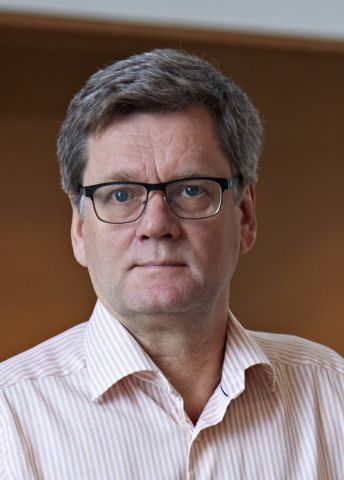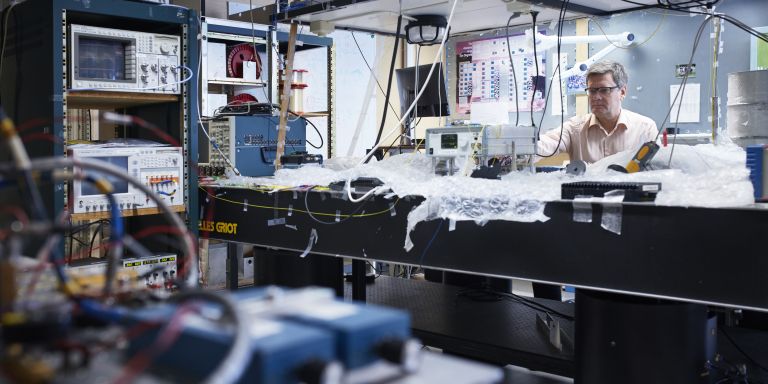
Peter Andrekson
Professor of Photonics
Wallenberg Scholar
Institution:
Chalmers University of Technology
Research field:
Fiber-optic communications


Wallenberg Scholar
Institution:
Chalmers University of Technology
Research field:
Fiber-optic communications
Manned flights to Mars have long been a dream of space scientists. NASA, the European Space Agency (ESA), and the private company SpaceX all have long-term plans to establish manned bases on the planet. But this will require communication systems with a higher capacity than those of today. Transmission of data from space probes close to Mars to the Earth has been identified as a particular bottleneck.
At present, radio waves are used to transmit information in space. Data transmission speeds are low – as low as about 30 kilobits per second from Mars. This may be compared with the average broadband speed in Sweden, which is approximately 60 megabits per second. But if laser links are used instead, speeds will increase dramatically.
Andrekson has already developed an optical amplifier capable of improving data transfer on fiber-optic networks. Over the past few years he and his research team have refined the technology so that it also works in a free space.
The form the technical solution might take was demonstrated in an article in the journal Nature Light Science & Applications in 2020.
“This is the best way of communicating over long distances. It’s difficult to achieve because losses are high, and the power you can transmit is limited. The constraints are fundamentally set by the sensitivity of the receiver, i.e. the amount of light you need to receive to decipher the information,” Andrekson explains.
Andrekson’s optical amplifier has been developed over the past ten years in the lab at Chalmers University of Technology. The fundamental theory existed as far back as the early 1980s, but no one had previously tested it in earnest.
“We had gained a sufficient understanding by 2011 to be able to demonstrate the system. Since then we have used the amplifier to enhance the performance of various types of fiber-optic system. It is only in the past four years that we have focused more on the space application,” Andrekson says.
“Being chosen as a Wallenberg Scholar gives me great scope to make a long-term commitment along a broad front, and to take risks that other grants do not allow.”
The late 1980s saw the development of optical amplifiers that made it possible to cover the whole world with a fiber-optic network, which is the backbone of the internet. But the technology is limited by the noise it creates, and the fact that non-linear effects in the fiber distort the signal. Andrekson’s optical amplifier solves both these problems.
Simply put, the technology may be described thus: the signal is split into two parts, which are made to interact with each other, creating amplification without generating extra noise. The light possesses properties: intensity, frequency, polarization and phase. Of these, it is the phase of the light that is affected, which is why the technology is also called “phase-sensitive amplification”.
“When we can control the relative phase between different wavelengths, they will interfere in the amplifier so that ‘one plus one equals four’ rather than two. A further advantage is that control of the relative phase does not create any additional noise,” Andrekson explains.
Up to now, the optical amplifier has required access to several hundred meters of fiber-optic cable wound around a drum. In collaboration with fellow researchers at Chalmers University of Technology, Andrekson’s team has recently developed a new platform in which a microchip about two centimeters across can accommodate eight separate amplifiers.
Silicon nitride is used on the chip to build up minute spirals that act as miniature waveguides. The chip has very low losses, and the ability to amplify light at many wavelengths. This offers potential for multiple applications. It could improve spectroscopy equipment or be used for satellite surveillance of the Earth with the help of advanced LIDAR systems. It is necessary to miniaturize the amplifier so the technology can be used in satellites or space probes.
In collaboration with MIT, NASA already has its own optical space communications system. The problem with their technology is that it requires superconducting nanowires that are cooled to 2–3 degrees Kelvin. Andrekson elaborates:
“Our solution can be used at room temperature, and has better sensitivity than theirs, even now. We need only one photon or light particle per bit of information, which is a level of sensitivity that no one else has managed to demonstrate.”
Andrekson’s research has been mainly based at Chalmers ever since he completed his undergraduate and postgraduate studies. But in the early 1990s he spent some time at Bell Labs in the U.S., where he was involved in developing erbium-doped amplifiers. At the same time, he conducted his own research into optical phenomena. On his return to Sweden part of the research was spun off in a company called Picosolve, which manufactured what was at the time the world’s fastest oscilloscope.
“One thing that drives me is the need to ensure our research findings have a real impact. Commercialization is one way of achieving that. And I’m also highly curious by nature, which is why funding like the Wallenberg Scholar grant is so crucial for progress to be made,” he says.
Text Magnus Trogen Pahlén
Translation Maxwell Arding
Photo Henrik Sandsjö